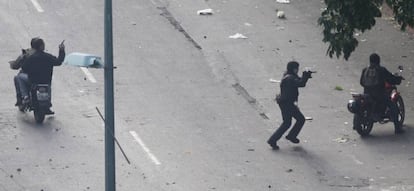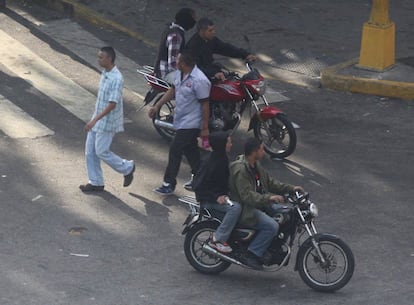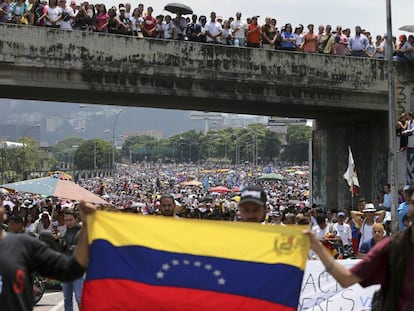Venezuela’s pro-government militias terrorizing opposition protest marches
Civilians accused of working with police and responsible for killings apparently operating with impunity

Of the 29 people now officially known to have died during the last month of anti-government protests in Venezuela, a significant number have been killed by so-called collectives, armed groups loyal to the ruling United Socialist Party set up by former president Hugo Chávez.
Paola Ramírez, who was gunned down on April 19 in the western state of Táchira, telephoned her mother, Darcy Gómez, to tell her that collectives were patrolling the streets of the state capital San Crístobal. “Mother, the collectives are shooting,” her mother says she told her.
The same day Ramírez died, 17-year-old Carlos Moreno Barón was shot in the head in Caracas. Witnesses said that gangs supporting President Nicolás Maduro were responsible.
The death toll over the last month looks set to exceed that of the four months of protests that rocked Venezuela in 2014
On Wednesday, amid continued opposition protests, two more people died: a university student in Caracas was hit in the chest by a tear-gas canister fired by police; in Táchira, a 28-year-old man was shot in the stomach by unknown assailants.
The opposition has organized a rally on Thursday outside the National Assembly and then a march to where the student was killed on Wednesday. Opposition leaders say they will resume protests on Monday.
The death toll over the last month looks set to exceed that of the four months of protests that rocked Venezuela in 2014.

So far, there have been few arrests over the killings. “Four deaths in the April protests have been attributed to these groups, but until now there have been no arrests,” said Lexys Rendón, head of the Observatorio de la Paz, an NGO that monitors political violence.
A 31-year-old man was arrested for the death of Ramírez. The government initially linked him to opposition party Vente Venezuela. “I want justice, real justice. I don’t believe it was him,” said Ramírez’s mother at her funeral.
The pro-Maduro militias first appeared during the protests of 2014.
That year, Vice Admiral Pedro Manuel Pérez, then the head of the Marine Infantry, warned Venezuela’s Defense Minister, Carmen Meléndez, and the high command that civilians in the capital were working with police to crush opposition protests.

Not only were Pérez’s warnings ignored, but he was also retired in May 2014, and last week was detained at his home by military intelligence accused of plotting to overthrow Maduro.
Rocío San Miguel, a lawyer with Control Ciudadano, a security forces watchdog, accused the government of sponsoring the collectives. “Allowing, sheltering, encouraging the activities of armed groups is a crime, and this has been going on continuously under the complacent gaze of the organs of the state, which have a legal duty to act,” she said.
They use violent methods to attack and disperse demonstrators, monitor neighborhoods, extort shopkeepers, and injure journalists
Rocío San Miguel from security forces watchdog Control Ciudadano
The collectives are extremely violent. San Miguel says they patrol demonstrations openly armed and on motorcycles, sometimes covering their faces, while shouting slogans in support of the government: “They act in a coordinated way under command structures they receive their instructions from. They use violent methods to attack and disperse opposition demonstrators, monitor neighborhoods, extort shopkeepers, and injure journalists and opposition leaders. They operate freely, knowing that they will not be arrested or charged for their crimes.”
The situation in oil-rich Venezuela has worsened in recent months, with a recession leaving millions unable to find or afford food amid shortages and worsening inflation.
The opposition blames Maduro, who is unpopular, and has been vying to remove him via a recall referendum. The former bus driver and union leader, however, has said the opposition is seeking a coup against him and has vowed to serve out his full term, which ends in 2019.
English version by Nick Lyne.
Tu suscripción se está usando en otro dispositivo
¿Quieres añadir otro usuario a tu suscripción?
Si continúas leyendo en este dispositivo, no se podrá leer en el otro.
FlechaTu suscripción se está usando en otro dispositivo y solo puedes acceder a EL PAÍS desde un dispositivo a la vez.
Si quieres compartir tu cuenta, cambia tu suscripción a la modalidad Premium, así podrás añadir otro usuario. Cada uno accederá con su propia cuenta de email, lo que os permitirá personalizar vuestra experiencia en EL PAÍS.
¿Tienes una suscripción de empresa? Accede aquí para contratar más cuentas.
En el caso de no saber quién está usando tu cuenta, te recomendamos cambiar tu contraseña aquí.
Si decides continuar compartiendo tu cuenta, este mensaje se mostrará en tu dispositivo y en el de la otra persona que está usando tu cuenta de forma indefinida, afectando a tu experiencia de lectura. Puedes consultar aquí los términos y condiciones de la suscripción digital.
More information
Últimas noticias
Maduro pleads not guilty before the federal court in New York: ‘I am still the president of Venezuela’
A new test can detect Alzheimer’s from a finger prick
UN team enters Sudanese city of El Fasher after paramilitary massacre: ‘It’s like a ghost town’
A recipe for resistance: Indigenous peoples politicize their struggles from the kitchen
Most viewed
- Gilles Lipovetsky: ‘If you want to live better and fall in love, take Prozac, don’t look to philosophy’
- Alain Aspect, Nobel laureate in physics: ‘Einstein was so smart that he would have had to recognize quantum entanglement’
- Maduro’s downfall puts China’s relationship with Venezuela to the test
- Why oil has been at the center of Venezuela-US conflicts for decades
- Alvin Hellerstein, a 92-year-old judge appointed by Bill Clinton, to preside over Maduro’s trial in New York










































